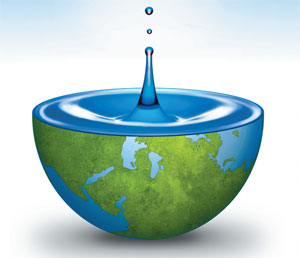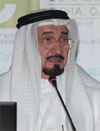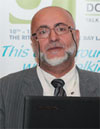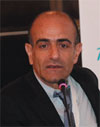A time to introspect … and act
Event report & snapshots from the C3 event held at Doha, Qatar in April 2012
- By Content Team |
- Published: June 13, 2012
Around 700 million people in 43 countries suffer from water scarcity. The alarming situation is closer home than we think. Awareness campaigns to educate people about water savings is not enough. The assessment system is not enough. We need regulations and we need to enforce them. Aggressive policies need to be implemented. And when it comes to district cooling, an integrated approach, taking into account cost-effective technologies and environmental impact mitigation is the need of the hour. These were the points hammered home during The Climate Control Conference (C3) Doha on April 10 and 11.
“Very soon, we will see a desalination plant every 200 kilometres in the GCC region,” said a participant, adding, “every year, we are going to increase the salinity of water. So, it is time to take stock of water.” Literally. And take stock the participants and delegates did. Held against the backdrop of water shortage in the world, across the region and Qatar, where the event took place, The Climate Control Conference with its avowed theme: “Optimising water use in district cooling, exploring macro-directions”, squarely faced up to a few pertinent questions:
- What are the lessons learnt so far?
- What are the challenges ahead?
- What macro directions should the industry take, vis-à-vis water usage?
- Out of the current and future expected water consumption of the country, what is the percentage needed by district cooling?
- Is it worth the exercise?
- If yes, would the possible savings, using latest technologies and available options, also be worth the exercise?
 The two-day conference, which saw technical presentations and panel discussions, with a spotlight on challenges and recent advancements in cooling towers, endeavoured to answer a host of questions by examining the various technologies and options, and listened to the received wisdom offered by the experts in the industry.
The two-day conference, which saw technical presentations and panel discussions, with a spotlight on challenges and recent advancements in cooling towers, endeavoured to answer a host of questions by examining the various technologies and options, and listened to the received wisdom offered by the experts in the industry.
With the tagline: “This time around, we are talking water!” C3 Doha had the avowed mission of some soul-searching. The tagline and the theme reflected the subtext – water is going to be a scarce commodity in Qatar and something needs to be done, and soon. According to estimates, water demand in Qatar will go up from 1.1 million m3/day in 2011 to 2.1 million m3/day in 2020. A large part of this increase is attributed to the needs of a growing population. Currently, the country depends largely on seawater desalination. But it evidently comes with a fine print – endangering the marine ecosystem.
The various presentations and panel discussions addressed these and related topics and came out with pertinent observations and recommendations. Fadhel Al Kazema, Tekneen Utilities, Kuwait clubbed the twin issues water and district cooling under discussion and hit the nail on its head when he said: “There is need to lower domestic oil consumption. You might reach a stage when there is no oil to export. And district cooling can help in reducing power consumption, which is generated through burning fossil fuels.” It was, indeed, time to face up to the water situation in Qatar and the region, especially in relation to district cooling. The recommendations and observations of the delegates and participants painted a stark picture of the ground reality. It was also a wakeup call: The time for procrastination is over. It is time to act.
Excerpts
 Salah Nezar, Qatar Project Management (QPM), listed the following facts:
Salah Nezar, Qatar Project Management (QPM), listed the following facts:
- Around 700 million people in 43 countries suffer from water scarcity.
- Water stress is defined as the situation where annual water supplies drop below 1,700 m3 per person.
- In the case of water scarcity, the annual water supplies drop below 1,000 m3 per person.
- In the case of absolute water scarcity, annual water supplies drop below “500 m3 per person
- By 2025, we will likely end up in very bad state: 1.8 billion people will be living in countries or regions with “Absolute Water Scarcity”. And two-thirds of the world’s population could be living under “Water Stressed” conditions.
- According to Kahramaa, water demand in Qatar is expected to double from 1.1 million m3/day to 2.1 million m3/day by 2020.
- In the GCC, average rainfall varies between 70 and 140 mm a year.
- Water consumption is increasing by eight to 10% every year.
- Very soon, we will see a desalination plant every 200 kilometres in the GCC region, which is a cause for concern. Every year, we are going to increase the salinity of water.
- The next time you put up a desalination plant, you will be forced to desalinate 8,000 ppm water instead of 4,000 ppm water, which means you will need to put more energy towards the desalination process to accommodate the additional ppm in the water.
- The year-on-year growth in production of water in Qatar is 9.7%, which is quite alarming.
- Equally of concern is NRW (Non Revenue Water) – leakage – which is quite high in Qatar; Kahramaa is trying to reduce the figure.
- According to Kahramaa, water leakage is estimated at 20%.
 Fadhel Al Kazema, Tekneen Utilities, Kuwait:
Fadhel Al Kazema, Tekneen Utilities, Kuwait:
- There is need for implementation of integration of infrastructure to include production of electricity in new cities, allowing exchange of power between the city energy production and the national grid, to be utilised in case of emergency or both.
- All GCC countries subsidise power. Cost of producing electricity in Kuwait is 38 fils per kilowatt hour, and they sell it for 2 fils. This is not realistic. When you opt for district cooling, you can deal with these things.
- It is important to address district energy and not district cooling.
- Let owners, construction managers and consultants provide outcome managements and refrain from exaggerated project input management. It is important to increase the integration of infrastructure services to lower fossil fuel usage and to increase alternative energy and technology and wastewater treatment.
 Ali Sleiman, ADC Energy Systems, said:
Ali Sleiman, ADC Energy Systems, said:
More than ethics, the issue really is with the subsidising of water and power, which is affecting the habits and cultural view of water resources, in general. Unless we take efforts to find where the leakages are and fix them, we will not achieve what we want.
 Ghaleb Abusaa, The Three Factors Company, believed that:
Ghaleb Abusaa, The Three Factors Company, believed that:
- It is not fair to blame the cooling tower manufacturers, because the design could be at fault, and also the O&M could be a problem. Improper cleaning of the cooling tower, for instance, can have an impact on its performance.
- The owner wants the cooling tower to be the best in the world, the engineer will put all the precautions in the world to ensure it will work in any conditions, and this is not the best approach. In Qatar, they design it at 32 for throughout the year. Why this practice?
 Antoine Stephan, Hamon CTC was of the opinion that:
Antoine Stephan, Hamon CTC was of the opinion that:
There is no data on losses or damages on cooling towers, because it really is a case-by-case basis, depending on the application and depending on the age. Of course, you have to go by CTI recommendations and ensure proper servicing of electro-mechanical equipment. It is important to check on the fill, empty spaces, etc. If you ensure proper maintenance, you can easily reach a life expectancy of 25 years. You have to monitor the operations, and that is according to the first design conditions we have.
 Radhia Mchirgui, 3E – Energy and Environment Engineering, Qatar:
Radhia Mchirgui, 3E – Energy and Environment Engineering, Qatar:
- The per capita water consumption in Qatar is 310 litres.
- The water network loss (leakage) is evaluated at 35%.
- The existing infrastructure for re-use of treated sewage effluent (TSE) is very poor in Qatar; almost 40% of TSE is thrown away.
- Qatar now re-uses 24% of total freshwater supplies; In contrast, it is only 16% for the whole of the GCC.
- Qatar is implementing a sustainability assessment system for getting energy efficiency (24% of the score) and water saving (16% of the score). In this context, Qatar has a National Strategic Plan 2030, including goals for sustainable water. One of the targets is to reduce water use by 83 litres per capita per day by 2030. This will be achieved as a first step by a Qatar National Development Strategy 2011-2016, published in March 2011, targeting a comprehensive Water Act.
- An integrated approach is needed to take into account cost-effective technologies for cooling towers and environmental impact mitigation: actual standard limit for Delta T = 3C.
- Awareness campaigns have to be conducted to educate people about water savings.
There is need to:
- Reduce network water losses
- To replace single-pass
- To use polymers for cooling towers in order to save 30% of make-up water through more than 50 cycles
- To change water regulation and tariff – some studies showed Qatar nationals can consume up to 1,200 litres/day per person, while expatriates consumed only 150 litres a day per person (because water cost for Qatar nationals is very low); and to put incentives for water and energy efficiency.
 Hassan Sultan, President of ASHRAE Oryx Chapter and the Director of Mechanical Department, MZ & Partners (Architectural and Engineering Consultancy), made the following observations:
Hassan Sultan, President of ASHRAE Oryx Chapter and the Director of Mechanical Department, MZ & Partners (Architectural and Engineering Consultancy), made the following observations:
- There are leakages underground. And metering should be considered for main lines, branches and sub-branches to detect the leakages.
- ASHRAE is ready to take up the subject and to assist in minimising leakage. ASHRAE Oryx Chapter would like to engage Kahramaa.
- The assessment system is not enough; we need regulations and we need to enforce the regulations.

 The two-day conference, which saw technical presentations and panel discussions, with a spotlight on challenges and recent advancements in cooling towers, endeavoured to answer a host of questions by examining the various technologies and options, and listened to the received wisdom offered by the experts in the industry.
The two-day conference, which saw technical presentations and panel discussions, with a spotlight on challenges and recent advancements in cooling towers, endeavoured to answer a host of questions by examining the various technologies and options, and listened to the received wisdom offered by the experts in the industry. Salah Nezar, Qatar Project Management (QPM), listed the following facts:
Salah Nezar, Qatar Project Management (QPM), listed the following facts: Fadhel Al Kazema, Tekneen Utilities, Kuwait:
Fadhel Al Kazema, Tekneen Utilities, Kuwait: Ali Sleiman, ADC Energy Systems, said:
Ali Sleiman, ADC Energy Systems, said: Ghaleb Abusaa, The Three Factors Company, believed that:
Ghaleb Abusaa, The Three Factors Company, believed that: Antoine Stephan, Hamon CTC was of the opinion that:
Antoine Stephan, Hamon CTC was of the opinion that: Radhia Mchirgui, 3E – Energy and Environment Engineering, Qatar:
Radhia Mchirgui, 3E – Energy and Environment Engineering, Qatar: Hassan Sultan, President of ASHRAE Oryx Chapter and the Director of Mechanical Department, MZ & Partners (Architectural and Engineering Consultancy), made the following observations:
Hassan Sultan, President of ASHRAE Oryx Chapter and the Director of Mechanical Department, MZ & Partners (Architectural and Engineering Consultancy), made the following observations: